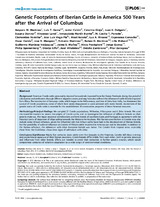Genetic Footprints of Iberian Cattle in America 500 Years after the Arrival of Columbus
Autor
Delgado-Bermejo, J.V.
Martínez Martínez, Amparo
Gama, Luis L.T.
Cañón, Javier
Ginja, Catarina
Dunner, Susana
Landi, Vincenzo
Martín-Burriel, I.
Penedo, M. Cecilia T.
Rodellar, Clementina
Vega-Pla, J.L.
Acosta, Atzel
Álvarez, Luz Ángela
Camacho Vallejo, M.E.
Cortés, Oscar
Marques, J.R.
Martínez, Roberto
Martínez, Ruben D.
Melucci, Lilia
Martínez-Velázquez, Guillermo
Muñoz, Jaime E.
Postiglioni, A.
Quiroz, Jorge
Sponenberg, Philip
Uffo, Odalys
Villalobos, Axel
Villalobos, Axel
Zaragoza, P.
Editor
Public Library of Science (PLOS)Fecha
2012Materia
American Creole cattleEuropean cattle
African cattle
Iberian cattle
Genetic footprint
METS:
Mostrar el registro METSPREMIS:
Mostrar el registro PREMISMetadatos
Mostrar el registro completo del ítemResumen
Background: American Creole cattle presumably descend from animals imported from the Iberian Peninsula during the period of
colonization and settlement, through different migration routes, andmay have also suffered the influence of cattle directly imported
from Africa. The introduction of European cattle, which began in the 18th century, and later of Zebu from India, has threatened the
survival of Creole populations, some of which have nearly disappeared or were admixed with exotic breeds. Assessment of the
genetic status of Creole cattle is essential for the establishment of conservation programs of these historical resources.
Methodology/Principal Findings: We sampled 27 Creole populations, 39 Iberian, 9 European and 6 Zebu breeds. We used
microsatellite markers to assess the origins of Creole cattle, and to investigate the influence of different breeds on their
genetic make-up. The major ancestral contributions are from breeds of southern Spain and Portugal, in agreement with the
historical ports of departure of ships sailing towards the Western Hemisphere. This Iberian contribution to Creoles may also
include some African influence, given the influential role that African cattle have had in the development of Iberian breeds,
but the possibility of a direct influence on Creoles of African cattle imported to America can not be discarded. In addition to
the Iberian influence, the admixture with other European breeds was minor. The Creoles from tropical areas, especially
those from the Caribbean, show clear signs of admixture with Zebu.
Conclusions/Significance: Nearly five centuries since cattle were first brought to the Americas, Creoles still show a strong
and predominant signature of their Iberian ancestors. Creole breeds differ widely from each other, both in genetic structure
and influences from other breeds. Efforts are needed to avoid their extinction or further genetic erosion, which would
compromise centuries of selective adaptation to a wide range of environmental conditions
Fuente
PLoS ONE 7(11) (2012)Ítems relacionados
Mostrando ítems relacionados por Título, autor o materia.
-
Molecular Study of the Amazonian Macabea Cattle History
Delgado-Bermejo, J.V.; Vargas, Julio; Landi, Vincenzo; Martínez, Amparo; Gómez, Mayra; Camacho, Esperanza; Álvarez, Luz Ángela; Aguirre-Riofrío, Lenin (Public Library of Science, 2016)Macabea cattle are the only Bos taurus breed that have adapted to the wet tropical conditions of the Amazon. This breed has integrated into the culture of the indigenous Shuar- Asuar nations probably since its origins, ... -
Structural and Technological Characterization of Tropical Smallholder Farms of Dual-Purpose Cattle in Mexico
Rangel Quintos, Jaime; Perea, José; Pablos-Heredero, Carmen de; Espinosa García, José Antonio; Toro Mújica, Paula Macarena; Feijoo, Marisa; Barba Capote, C.J.; García Martínez, Antón Rafael (MDPI, 2020)Dual-purpose cattle smallholder farms (DP) exhibit a critical economic situation. The objective of this research was building a typology for DP in tropical conditions and characterizing them technologically. This will help ... -
Analyses of Genetic Diversity in the Endangered “Berrenda” Spanish Cattle Breeds Using Pedigree Data
González-Cano, Rafael; González Martínez, A.; Muñoz Mejías, Eva; Valera, Pablo; Rodero Serrano, E. (MDPI, 2022)Pedigree analyses of two endangered cattle breeds were performed in order to study the structure and the genetic variability in their populations. Pedigree data were analyzed from 12,057 individuals belonging to the “Berrenda ...

